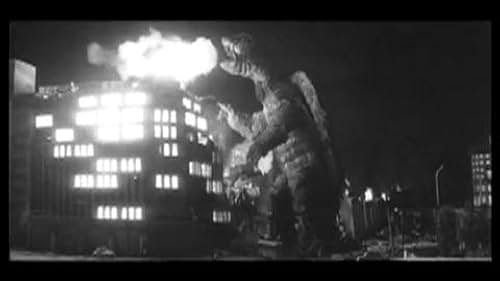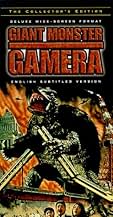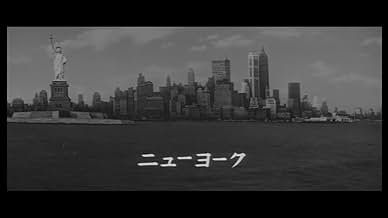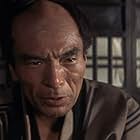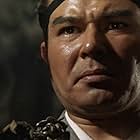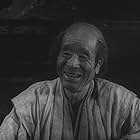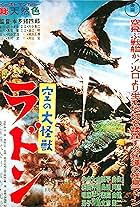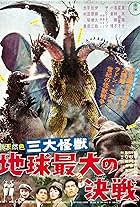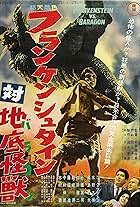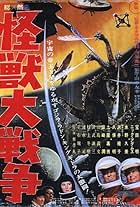IMDb RATING
5.2/10
3.9K
YOUR RATING
From out of the arctic comes a gigantic flying, fire-breathing turtle that sets its sights on destroying Tokyo.From out of the arctic comes a gigantic flying, fire-breathing turtle that sets its sights on destroying Tokyo.From out of the arctic comes a gigantic flying, fire-breathing turtle that sets its sights on destroying Tokyo.
Junichiro Yamashita
- Aoyagi
- (as Junichirô Yamashiko)
- Director
- Writer
- All cast & crew
- Production, box office & more at IMDbPro
Storyline
Did you know
- TriviaGamera's role as a guardian of children came from director Noriaki Yuasa's own traumatic experiences growing up as a child during WWII. He mentioned that all the adults and teachers he knew would constantly implant to him the importance of nationalism and Imperial Japan's ambitions, only to abandon it all after Japan's defeat. He recounted the story of how of a teacher of his switched from being a outspoken Nationalist into an advocating Communist. Yuasa had also been a child actor and the behavior he witnessed from them lead him to develop a disapproval of actors in general. These sentiments were carried into the making of Gamera, which Yuasa conceived as the only entity children could have faith in.
- GoofsIn the English language version, special effects director Yonesaburo Tsukiji is mistakenly credited as Yonesaburg Tsukiji.
- Quotes
[English version]
Mr. Sakurai: Gamera saved your life.
Kenny: Because he knows I like turtles.
Nobuyo Sakurai: Gamera liked you. Gamera must have a good heart.
Kenny: Gamera's a good turtle.
- Alternate versionsNot released in the USA until 1985, to home video and television, by Sandy Frank under the title GAMERA. To that day, the only way to (partially) see it was the movie Gammera the Invincible (1966), which used the special effects footage from the original Japanese film but most scenes involving human actors were replaced by new ones featuring an American cast. The Sandy Frank version, one of his usual dubbing jobs, was the whole original Japanese footage except for the opening credits sequence, replaced by English translated credits superimposed over an image of moving ocean water. Another difference is that in the Frank dub the names of some characters are Americanized (i.e. Toshio is renamed Kenny).
- ConnectionsEdited into Gammera the Invincible (1966)
Featured review
Gamera's debut film and the rise legendary rival of Godzilla as the King of Japanese monster cinema. I'm going to say this right now, but I'm not much of a fan of Gamera's early films. There were a few interesting ones, like "Gamera vs. Gyaos" and "Gamera vs. Barugon", however, the original series went to sh*t at a much faster rate than the showa Godzilla films. 1968's "Gamera vs. Viras" is a staple to that statement and of course the series would only get worse till the 80s film "Gamera: Super Monster". This film isn't as good as "Gamera vs. Gyaos" and "Gamera vs. Barugon", but is far superior to latter entries.
Positive notes, well for his debut, Gamera looks pretty awesome. The city stomping scenes are well done, of course Japanese studios by 1965 having had lots of practice. The pacing is brisk and believe it or not doesn't drag. Most kaiju films have interesting finales and if you haven't seen this one you'll either laugh or sit in awe. Either way good fun. And the score is far from Akira Ifukube quality, with wildly switching moods, but it hold together.
Bad points, eh, too much borrowed from other monster movies. A monster emerging from the ice, obviously lifted from "Beast from 20, 000 Fathoms" and the black and white look of the film is borrowed, if you will, from the original 1954 Gojira. I suppose that's what happens when you come in that lame in the game. Plus the child character kind of grated on my nerves, a true turtle lover all right. The movie takes itself rather seriously with notions of the Cold War as opposed to the 1965 Toho release "Invasion of Astro Monster" which was light-hearted but more memorable. That film had awesome colorful cinematography, the likes of three monsters (Godzilla, Rodan, and King Ghidorah!!" and a fun and yes zany plot. Plus it was scored by the maestro Akira Ifukube. Comparing it to this film isn't really fair, but Godzilla for the win this round.
However, I still highly enjoy the vintage sci-fi and I recommend the movie to classic sci-fi lovers.
Positive notes, well for his debut, Gamera looks pretty awesome. The city stomping scenes are well done, of course Japanese studios by 1965 having had lots of practice. The pacing is brisk and believe it or not doesn't drag. Most kaiju films have interesting finales and if you haven't seen this one you'll either laugh or sit in awe. Either way good fun. And the score is far from Akira Ifukube quality, with wildly switching moods, but it hold together.
Bad points, eh, too much borrowed from other monster movies. A monster emerging from the ice, obviously lifted from "Beast from 20, 000 Fathoms" and the black and white look of the film is borrowed, if you will, from the original 1954 Gojira. I suppose that's what happens when you come in that lame in the game. Plus the child character kind of grated on my nerves, a true turtle lover all right. The movie takes itself rather seriously with notions of the Cold War as opposed to the 1965 Toho release "Invasion of Astro Monster" which was light-hearted but more memorable. That film had awesome colorful cinematography, the likes of three monsters (Godzilla, Rodan, and King Ghidorah!!" and a fun and yes zany plot. Plus it was scored by the maestro Akira Ifukube. Comparing it to this film isn't really fair, but Godzilla for the win this round.
However, I still highly enjoy the vintage sci-fi and I recommend the movie to classic sci-fi lovers.
- How long is Gamera: The Giant Monster?Powered by Alexa
Details
- Runtime1 hour 21 minutes
- Color
- Aspect ratio
- 2.35 : 1
Contribute to this page
Suggest an edit or add missing content

Top Gap
By what name was Gamera: The Giant Monster (1965) officially released in India in English?
Answer

